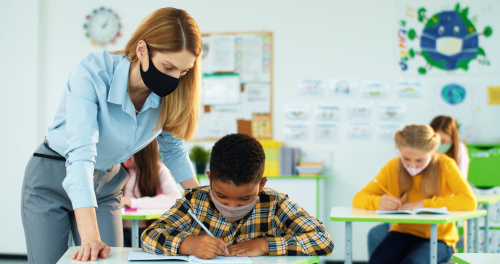A defining feature of the COVID-19 pandemic is the haze of uncertainty in which we now live. Are cases rising or falling? Which activities are deemed “safe” for the vaccinated? And now that most U.S. schools have re-opened in person, will they stay open, and can they keep COVID-19 at bay?
This uncertainty has landed heavily on teachers and contributed to teacher stress. For several reasons, the jobs to which they returned in fall 2021 are more challenging than what they faced in the pre-COVID world.
First, at a time in which vaccines remain unapproved for children under 12, and in which many older children remain unvaccinated, teachers worry about students’ health and their own. They recognize that social distancing is at odds with many student-centered teaching techniques, and they don’t want to spend their days as mask enforcers, but they also want to stay safe. In a nationally representative survey of teachers conducted by RAND earlier this year, 16 percent of teachers ranked concern for their own health as their top source of job-related stress, and 17 percent said their top concern was for the health of loved ones at home with high COVID risk.
Second, teachers worry that a rapidly changing COVID situation means they will have to transition students back to hybrid or wholly virtual teaching models if students or staff start getting sick. In the 2021 RAND survey, teachers reported that hybrid teaching models, in which they had to simultaneously teach in-person and online, were the most stressful teaching approach.
Finally, teachers are grappling with the widely varying academic and emotional needs of their students. Though some students thrived under virtual and at-home learning, many others struggled or were unable to engage at all due to technological or personal constraints. Some students and teachers alike faced major crises during the pandemic, including the deaths and serious illnesses of loved ones. Given that Black, Indigenous, and Latinx communities have been hit hardest by the pandemic, the personal hurdles to returning to school are especially high in these communities. As teachers take stock of their students’ complex needs, and their own, they must find ways to move forward without ignoring the hardships of the past year. This is a daunting task.
Fortunately, there are steps school systems can take to help teachers cope with additional stress. First, schools must prioritize community health and safety. This may mean using funds from the 2021 American Rescue Plan for the provision of infrastructure such as functional air ventilation systems, windows that open, and safe outdoor spaces for eating and play. Depending on COVID case rates in the community, it may include requiring that students wear masks, or even that students 12 and over be vaccinated, as the Los Angeles Unified School District recently voted to do.
Second, schools can clarify the procedures they will use if student quarantine or school closure becomes necessary. For instance, they may wish to help teachers streamline the posting of assignments each week in an online learning management system. This way, students and parents will always know where to locate assignments and due dates, whether accessing them from school or home.
Third, professional development should help teachers adapt the existing curriculum to students’ varying academic needs. Meanwhile, policymakers should avoid basing school or teacher evaluations on students’ test scores in the current academic year, because many teachers will be adapting the curriculum to revisit content students missed in the previous year.
Finally, to help teachers and students manage difficult emotions related to the pandemic, schools may wish to provide training in mindfulness and stress management. Several well-designed studies in public schools have demonstrated the effectiveness of low-cost mindfulness programs for reducing teacher burnout and student stress and enhancing students’ emotional regulation skills.
It is understandable that many teachers will face anxiety in returning to in-person schooling during a pandemic. But if schools place community well-being at the forefront of their planning, they can help create safe havens for learning in uncertain times.
- 7 reasons to ditch recipe-style science labs - November 22, 2024
- As a paradeducator, here’s how I use tech to help neurodivergent students gain agency - November 22, 2024
- 5 ways school districts can create successful community partnerships - November 21, 2024


